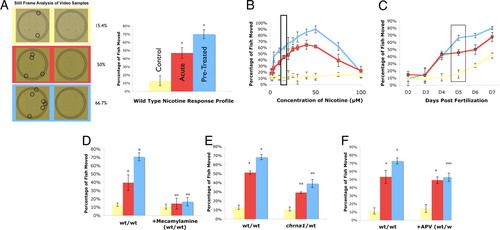
Nicotine response profiling of zebrafish larvae. Locomotion of zebrafish larvae was assessed using sibling animals. Yellow datasets (Control) indicate basal locomotion rates (no stimulation). Red datasets (Acute) demonstrate locomotion rates during a single exposure to nicotine. Blue datasets (Pretreated) indicate locomotion rates during nicotine exposure in fish that had been pretreated with a single, brief exposure to nicotine 8 h prior (see Experimental procedures). All data points represent at least three independent measurements on independent biological samples with at least 10 animals measured for each replicate. (A) Representative data for standard nicotine response profile conditions. Video imaging of a single behavioral analysis is shown at left. Movement rates were determined as a function of differential location (circled fish) during a standard time window of 0.25 s (middle). A standard wild-type response profile of 5-day-old zebrafish is shown (right); this profile examines normal movement rates (Control), movement as a function of a single nicotine treatment (Acute), and shows the increased locomotor activity over an acute response after receiving multiple doses of nicotine (Pretreated). (B) Dose–response of 5-day-old zebrafish to nicotine. Zebrafish show an increase in movement for doses from 2.5–50 μM doses of nicotine. The greatest difference in movement between the acute and pretreated fish occurs in doses between 10 and 25 μM; the main dose used for the subsequent work (10 μM) is highlighted by the black box. Note the inverted-U-shape of the curve, with animals showing reduced movement enhancement at doses above 50 μM nicotine. (C) Zebrafish respond to nicotine at 4 days of age and not before. Zebrafish can be sensitized to nicotine at 5 days of age and not before, highlighted by the black box. (D) Mecamylamine, a central nervous system specific nicotinic competitive inhibitor, quenches the overall nicotine response when added before the testing dose of nicotine without affecting the basal locomotion rate in the absence of nicotine. (E) chrna1 heterozygous fish exhibit a reduced nicotine response when compared to their wild-type siblings. (F) APV, an NMDAR competitive inhibitor, quenches the development of the sensitization response when added concurrently with initial nicotine dose. *, P < 0.05 when comparing to control or acute. **, P < 0.05 when comparing to corresponding treatment group. ***, P < 0.05 when comparing to control, but not acute. Also P < 0.05 when comparing to the corresponding treatment group.
|

